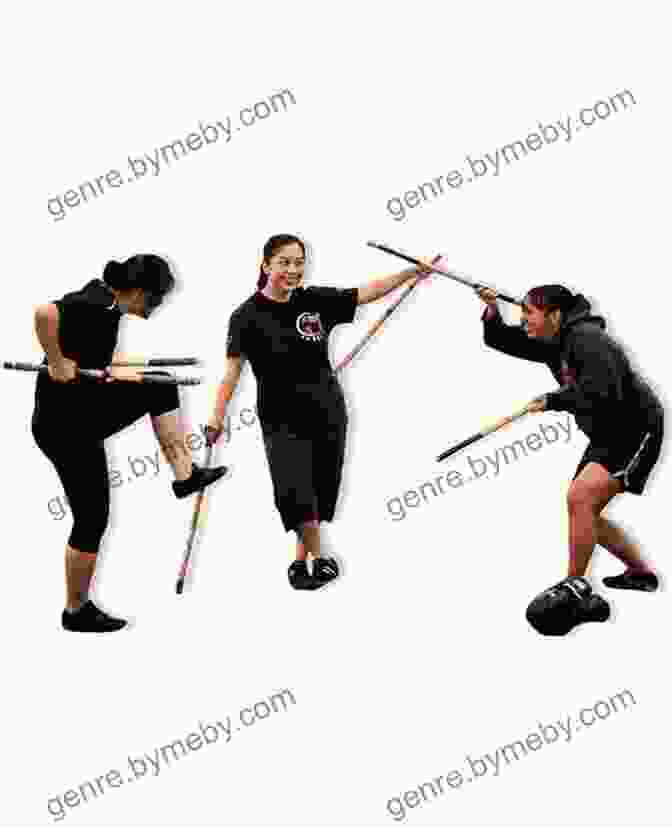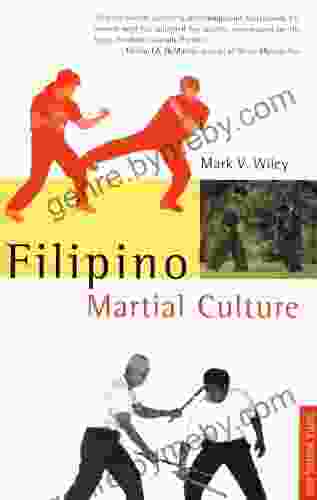Filipino Martial Culture: A Comprehensive Guide


4.6 out of 5
| Language | : | English |
| File size | : | 6487 KB |
| Text-to-Speech | : | Enabled |
| Screen Reader | : | Supported |
| Enhanced typesetting | : | Enabled |
| Print length | : | 378 pages |
The Philippines is a country with a rich and diverse martial culture. Filipino martial arts, collectively known as FMA, have been developed over centuries and are a unique blend of indigenous techniques and influences from Southeast Asia, China, and Spain.
FMA encompasses a wide range of styles, including eskrima, kali, and arnis. These styles are characterized by their use of weapons, such as sticks, knives, and swords. However, FMA also includes unarmed techniques, such as grappling, striking, and kicking.
Filipino martial culture is not just about fighting. It is also a way of life. FMA practitioners believe that martial arts can help people to develop their physical, mental, and spiritual strength.
History of Filipino Martial Culture
The origins of FMA can be traced back to the pre-colonial period. The indigenous people of the Philippines developed a variety of fighting techniques to defend themselves from invaders and to hunt for food.
When the Spanish arrived in the Philippines in the 16th century, they introduced their own martial arts, such as fencing and wrestling. These Spanish influences were incorporated into FMA, and new styles were developed.
In the 19th century, FMA began to spread to other parts of the world. Filipino martial artists traveled to Europe, North America, and Asia, and they taught their skills to people from all walks of life.
Techniques of Filipino Martial Culture
FMA is a comprehensive martial art that includes a wide range of techniques.
Weapons Training
Weapons training is a key component of FMA. Filipino martial artists use a variety of weapons, including sticks, knives, and swords.
Sticks are the most common weapon used in FMA. They can be used for a variety of purposes, such as striking, blocking, and disarming opponents.
Knives are also commonly used in FMA. Filipino martial artists learn how to use knives for both self-defense and combat.
Swords are the most prestigious weapons in FMA. They are used for both ceremonial purposes and combat.
Unarmed Techniques
FMA also includes a wide range of unarmed techniques. These techniques include grappling, striking, and kicking.
Grappling techniques are used to control and subdue opponents. Filipino martial artists learn how to use a variety of grappling techniques, such as throws, takedowns, and joint locks.
Striking techniques are used to attack opponents with punches, kicks, and elbows. Filipino martial artists learn how to use a variety of striking techniques, such as jabs, crosses, and hooks.
Kicking techniques are used to attack opponents with the feet. Filipino martial artists learn how to use a variety of kicking techniques, such as roundhouse kicks, side kicks, and front kicks.
Cultural Significance of Filipino Martial Culture
FMA is not just a martial art. It is also a way of life. FMA practitioners believe that martial arts can help people to develop their physical, mental, and spiritual strength.
FMA is also a source of national pride for Filipinos. Filipino martial artists have represented their country in international competitions and have won numerous awards.
The cultural significance of FMA is undeniable. It is a living tradition that has been passed down from generation to generation. FMA is a symbol of Filipino identity and a source of pride for the Filipino people.
Filipino martial culture is a rich and diverse tradition that has been developed over centuries. FMA is a comprehensive martial art that includes a wide range of techniques, from weapons training to unarmed combat. Filipino martial culture is also a way of life, and it teaches people how to develop their physical, mental, and spiritual strength.
If you are interested in learning more about Filipino martial culture, there are many resources available online and in libraries. You can also find FMA schools in many cities and towns around the world.
4.6 out of 5
| Language | : | English |
| File size | : | 6487 KB |
| Text-to-Speech | : | Enabled |
| Screen Reader | : | Supported |
| Enhanced typesetting | : | Enabled |
| Print length | : | 378 pages |
Do you want to contribute by writing guest posts on this blog?
Please contact us and send us a resume of previous articles that you have written.
 Book
Book Novel
Novel Page
Page Chapter
Chapter Text
Text Story
Story Genre
Genre Reader
Reader Library
Library Paperback
Paperback E-book
E-book Magazine
Magazine Newspaper
Newspaper Paragraph
Paragraph Sentence
Sentence Bookmark
Bookmark Shelf
Shelf Glossary
Glossary Bibliography
Bibliography Foreword
Foreword Preface
Preface Synopsis
Synopsis Annotation
Annotation Footnote
Footnote Manuscript
Manuscript Scroll
Scroll Codex
Codex Tome
Tome Bestseller
Bestseller Classics
Classics Library card
Library card Narrative
Narrative Biography
Biography Autobiography
Autobiography Memoir
Memoir Reference
Reference Encyclopedia
Encyclopedia Jack Kirby
Jack Kirby Knowledge Flow
Knowledge Flow Sonia Nieto
Sonia Nieto Philippe Karl
Philippe Karl Robert H Ruby
Robert H Ruby Sandee Cohen
Sandee Cohen Stephen J Whitfield
Stephen J Whitfield Samuel John
Samuel John Klaus Carl
Klaus Carl Marie Blair
Marie Blair Linda Sue Park
Linda Sue Park Sheri Wall
Sheri Wall Susan Page
Susan Page Naomi Wallace
Naomi Wallace Nancy Kennedy
Nancy Kennedy Zoe Moore
Zoe Moore Rachel Eskandari
Rachel Eskandari Sophie Blackall
Sophie Blackall Phil Robertson
Phil Robertson Lady Colin Campbell
Lady Colin Campbell
Light bulbAdvertise smarter! Our strategic ad space ensures maximum exposure. Reserve your spot today!
 Michael SimmonsFollow ·10.7k
Michael SimmonsFollow ·10.7k Francis TurnerFollow ·17.5k
Francis TurnerFollow ·17.5k Oscar BellFollow ·7k
Oscar BellFollow ·7k Octavio PazFollow ·19.4k
Octavio PazFollow ·19.4k Nick TurnerFollow ·3.1k
Nick TurnerFollow ·3.1k Gage HayesFollow ·7.4k
Gage HayesFollow ·7.4k Ronald SimmonsFollow ·7.8k
Ronald SimmonsFollow ·7.8k James HayesFollow ·8.8k
James HayesFollow ·8.8k

 Lee Simmons
Lee SimmonsUnveiling the Enchanting Emerald Isle: A Literary Journey...
A Tapestry of Breathtaking...

 Thomas Hardy
Thomas HardyUnveiling Costa Rica's Enchanting Essence with Lonely...
Embark on an Unforgettable Costa Rican...
 Bryan Gray
Bryan GrayLifting the Veil of Sorrow: A Beacon of Hope for Widowers
Embrace Healing and Find Solace in the...

 John Updike
John UpdikeGrow Your Business and Legacy: An Inspiring Guide for...
Growing Up In The Family Business is an...

 Harrison Blair
Harrison BlairLonely Planet's Western Europe Travel Guide: Your...
Are you planning an unforgettable...
4.6 out of 5
| Language | : | English |
| File size | : | 6487 KB |
| Text-to-Speech | : | Enabled |
| Screen Reader | : | Supported |
| Enhanced typesetting | : | Enabled |
| Print length | : | 378 pages |














